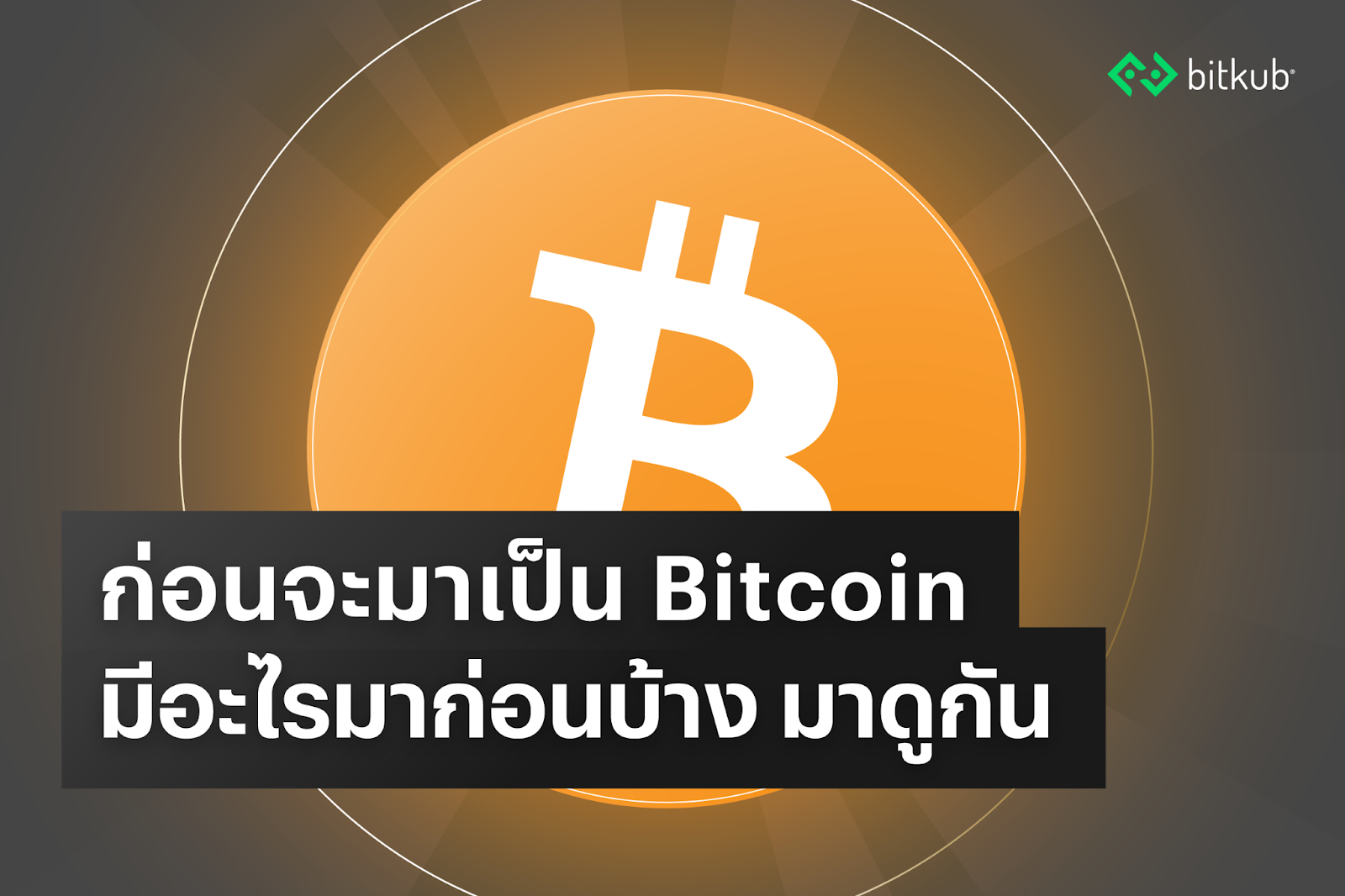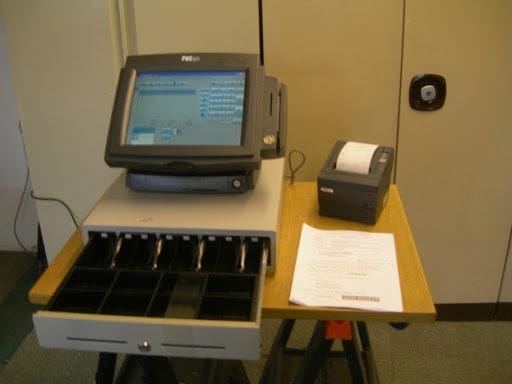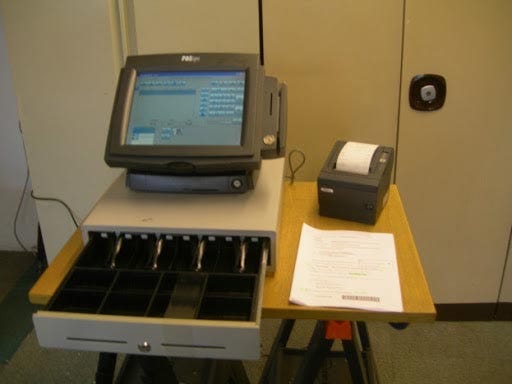บทความ
ก่อนจะมาเป็น Bitcoin มีอะไรบ้าง? มาดูกัน!

(Scroll down for English)
ปัจจุบัน ทุกคนน่าจะเริ่มคุ้นเคยกันแล้วว่า Bitcoin คืออะไร แต่น้อยคนนักที่จะรู้ว่าก่อนมันจะเกิดขึ้นมา มีความพยายามสร้างสกุลเงินดิจิทัลอะไรบ้าง ทำไมถึงไม่ประสบความสำเร็จ แล้ว Bitcoin ได้เรียนรู้อะไรจากสิ่งที่เกิดขึ้นบ้าง
ในบทความนี้ เราจะมาดูกันว่ามีสกุลเงินดิจิทัลอะไรบ้างที่มาก่อน Bitcoin และสกุลเงินเหล่านั้นได้กลายมาเป็นพื้นฐานให้ Bitcoin อย่างไร
เงินดิจิทัลสกุลแรกของโลก

ในช่วงปี 1980 ปั๊มน้ำมันในประเทศนเธอร์แลนด์ประสบปัญหาถูกปล้นเงิดสดตอนกลางคืน จึงเกิดความคิดสร้างเป็นบัตร Smart card เพื่อให้คนขับรถสามารถนำบัตรมาใช้แทนเงินสดได้ เมื่อไม่ต้องเก็บเงินสดไว้กับตัว ก็สามารถลดการโจรกรรมลงไปได้
เจ้าบัตร Smart card ต่อมาก็ได้กลายเป็นต้นแบบของเครื่องรูดบัตรเครดิตในปัจจุบันนี่เอง
DigiCash

ในปี 1983 David Chaum ได้ออกเอกสาร Untraceable Electronic Mail, Return Addresses, and Digital Pseudonyms ซึ่งก็คือสกุลเงินดิจิทัลที่ชื่อว่า DigiCash ที่ใช้ Blind Signature สำหรับการเข้ารหัสข้อมูลธุรกรรมระหว่างผู้ใช้
ต่อมาแนวคิด Blind Signature ก็กลายเป็นต้นแบบของ Public Key กับ Private Key ของ Bitcoin
B-Money

ในปี 1998, Wei Dai วิศวกรคอมพิวเตอร์ ได้ออกเอกสาร B-Money สกุลเงินดิจิทัลที่ใช้การเข้ารหัสข้อมูลธุรกรรม คล้ายกับ DigiCash แต่มีความกระจายอำนาจ (Decentralized) โดยให้เครื่องคอมพิวเตอร์ในเครือข่ายช่วยกันตรวจสอบความถูกต้องของธุรกรรม
แนวคิดนี้จึงกลายเป็นพื้นฐานของ Blockchain แบบ Proof-of-Work ที่ Bitcoin รวมถึงเครือข่าย Blockchain อื่น ๆ ใช้กันในปัจจุบัน
Bit Gold

นาย Nick Szabo นักวิทยาศาสตร์คอมพิวเตอร์ ผู้ที่หลายคนน่าจะรู้จักกันในฐานะผู้บุกเบิกแนวคิด Smart contract โดยในปี 1998 Nick ได้ออกเอกสาร Bit Gold ที่เครื่องคอมพิวเตอร์ในเครือข่ายจะแข่งกันแก้สมการแลกกับสิทธิ์ในการยืนยันธุรกรรม
ถึงแม้ว่า Bit Gold จะไม่ได้ถูกใช้งาน แต่ก็มีความคล้ายกับ Bitcoin มาก ถึงขั้นมีคนตั้งคำถามว่า Nick Szabo คือ Satoshi Nakamoto หรือเปล่า? แต่ทาง Nick Szabo ก็ได้ออกมาปฏิเสธว่าไม่ใช่ในเวลาต่อมา
HashCash

HashCash เกิดขึ้นในปี 1997 สร้างขึ้นโดย Adam Beck นักวิทยาการเข้ารหัส (Cryptographer) โดย HashCash ใช้ระบบ Proof-of-Work เพื่อตรวจสอบความน่าเชื่อถือของธุรกรรม โดยมีพื้นฐานมาจากระบบที่ใช้สำหรับการลดจำนวนอีเมล์ที่เป็นสแปม แต่ไม่ประสบความสำเร็จ เนื่องจากข้อจำกัดทางด้านเทคโนโลยี เพราะว่าเครื่องคอมพิวเตอร์ในสมัยนั้นยังไม่สามารถประมวลผลเพื่อแก้ไขสมการทางคณิตศาสตร์ได้เร็วพอ
สรุป
จากตัวอย่างที่ยกมา จะเห็นได้ว่าก่อนหน้า Bitcoin ก็มีการสร้างสกุลเงินดิจิทัลขึ้นมาหลายสกุล ถึงจะไม่ประสบความสำเร็จอย่าง Bitcoin เนื่องจากข้อจำกัดต่าง ๆ บ้างก็มาเร็วไป บ้างก็ติดข้อจำกัดทางเทคโนโลยี แต่ก็ได้เป็นพื้นฐานให้กับ Bitcoin เช่น DigiCash ที่เป็นพื้นฐานด้านการเข้ารหัสข้อมูล, B-Money กับแนวคิดกระจายอำนาจ, หรือ Bit Gold กับ HashCash ต้นแบบระบบ Proof-of-Work และเทคโนโลยี Blockchain
Satoshi Nakamoto ได้นำจุดเด่นของสกุลเงินดิจิทัลในอดีตมาสร้าง Bitcoin ที่ปัจจุบันกลายเป็นคริปโทเคอร์เรนที่มีมูลค่าตลาดรวมสูงที่สุดในโลก และเริ่มได้รับบการยอมรับจากบริษัทยักษ์ใหญ่ สถาบันการเงิน ไปจนถึงระดับรัฐบาล
ขณะที่เทคโนโลยีบล็อกเชนก็ถูกนำไปพัฒนาต่อยอด เกิดเป็นคริปโทเคอร์เรนซี หรือ Altcoin อีกหลายสกุล รวมถึงเทคโนโลยีใหม่อย่าง DeFi และ NFT จึงเป็นที่น่าจับตาอย่างยิ่งว่า Bitcoin จะเปลี่ยนวิถีเศรษฐกิจโลกไปในทิศทางไหนกันนะ
อ้างอิง Comprar Bitcoin, Bitcoin Magazine, HackerNoon
— — — — —
What came before Bitcoin? Let’s see
Everyone is probably familiar with Bitcoin now, but few know what kind of digital currency initiatives have been undertaken? Why did it fail, and what did Bitcoin learn from?
Let’s learn about what digital currency that existed before Bitcoin and how they provided the foundation for Bitcoin in this article.
The First Digital Currency

In the 1980s, gas stations in the Netherlands were targeted by robbery at night. As a result, a Smart card was developed that could be used instead of cash by the customers. When you don’t need to carry cash around, the risk of theft is reduced significantly. Smart card readers were eventually developed into the prototype for today’s credit card machines.
DigiCash

David Chaum published Untraceable Electronic Mail, Return Addresses, and Digital Pseudonyms in 1983, which led to the creation of DigiCash, a digital currency that employs blind signatures to encrypt transaction data between users. The Blind Signature later evolved into the Public Key and Private Key of Bitcoin.
B-Money

Wei Dai, a computer engineer, launched B-Money in 1998, a decentralized digital currency comparable to DigiCash. B-Money is being decentralized by allowing computers on the network to assist in verifying the transaction. The Proof-of-Work Blockchain, which is used by Bitcoin and other Blockchain networks today, is based on this notion.
Bit Gold

Computer Scientist, Mr. Nick Szabo Nick, who is widely regarded as the father of the Smart contract concept, published the Bit Gold whitepaper in 1998, in which computers on the network competed to solve an equation in return for the right to validate a transaction.
Although Bit Gold could not become a reality, it was so similar to Bitcoin that some wonder if Nick Szabo is Satoshi Nakamoto. Nick Szabo, on the other hand, later rejected it.
HashCash

Adam Beck, a cryptographer, invented HashCash in 1997. HashCash used a Proof-of-Work system to verify the transaction. It was based on the system that aims to reduce email spam. However, due to technological limitations, it was not successful, because computers at the time couldn’t process mathematical equations quickly enough.
Summary
As you can see, many digital currencies existed before Bitcoin. Even though, they were not as successful as Bitcoin due to technological restrictions or other reason, they become the vital foundation for Bitcoin, such as DigiCash, a cryptographic data platform, B-Money, and the notion of decentralization, or Bit Gold and HashCash, a Proof-of-Work and Blockchain prototype.
Satoshi Nakamoto built Bitcoin on the qualities of previous digital currencies, and it is today the world’s most valuable cryptocurrency, accepted by big corporations and financial institutions, all the way up to the federal government
Although blockchain technology is still being developed, it will be interesting to see how Bitcoin affects the global economy, given the advent of multiple cryptocurrencies or altcoins, as well as innovative technologies such as DeFi and NFT.
Reference Comprar Bitcoin, Bitcoin Magazine, HackerNoon
ที่มา:
Medium